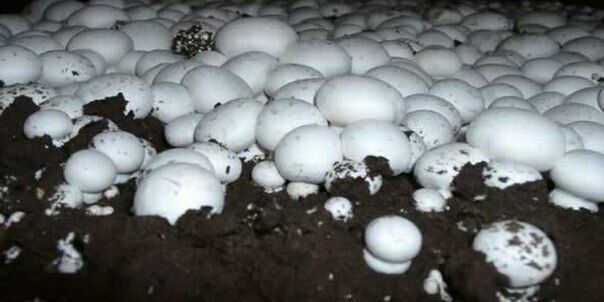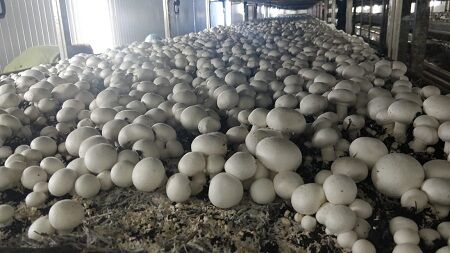Demand for mushrooms is growing and more and more enterprises for their cultivation appear. If you are planning to organize production for growing mushrooms, in order to get a good harvest and profit, you need to know in what climate do mushrooms grow in and how to ensure these conditions.

In the article, we will consider the biological features of champignons, their structure, and their stages of development. Let’s determine what indicators of humidity, temperature, and illumination are optimal for the growth of mushrooms. Let’s figure out what climate and environment conditions are needed for nutrition, and what substances should be contained in the substrate.
Table of Contents
Mushroom Biological features, structure
Champignons belong to agaric mushrooms. In nature, 2 types grow in fields and forests. On an industrial scale, two-spored champignons of 3 varieties are cultivated: brown, cream, and the most common – white.
Edible also includes a four-spore Agaricus bitorquis mushroom. It is easy to grow, it is not whimsical to temperature and carbon dioxide content, it is practically not affected by diseases, but due to its slow growth, it is rarely used.
The body of mushrooms is divided into 2 parts: mycelium and the fruiting body. The mycelium consists of thin white-blue threads, which become thicker and denser as they grow. The hyphae are covered with protective substances that provide color to the mycelium and cap. The thin integumentary tissue on the cap is nothing more than intertwined thin hyphae. To grow, the fungus needs from 7 to 10 days, if counted from the moment the rudiment of the fruiting body appears. Mushrooms are eaten young, the stem is 1-2 cm long, and there is a film between the stem and the cap.
The mycelium is located inside the substrate, it can remain viable for several years. Under favorable conditions, the rudiments of fruiting bodies begin to form on the mycelium. They grow and are divided into a leg and a hat. The plates on which spores are formed are located on the lower surface of the cap. The productivity of champignons is amazing, about one billion spores are sown per day. When they enter the nutrient medium, they germinate with mycelium.
Cultivation of champignons Mushroom:
- Vegetatively. Fragments of hyphae or hymenial tissues are planted in a nutrient medium. The new mycelium grows rapidly, it is again divided and seated.
- Disputes. This method is suitable for breeding, planting material is obtained clean from pests and diseases.
what climate do mushrooms grow in?
In short, climate needed to mushrooms grow in:
- Mushrooms grow in a wide range of climates
- They prefer a moist environment
- They can grow in warm or cool climates
- The climate affects the flavor of the mushrooms
- Some mushrooms can only grow in certain climates
- Mushrooms are sensitive to changes in climate

Let discuss What is the best climate to grow mushrooms and what Environment for Mushroom Growth is needed.
mushrooms need light to grow
Lighting is not required in industrial premises; champignons grow well in the dark. It is better that there are no windows since the penetration of light violates the temperature regime. When installing lighting equipment, you need to make sure that it has a minimal impact on the microclimate during planting care and harvesting.
ventilation
In a closed room, active ventilation equipment is indispensable. The air should change about 16 volumes per hour. Fruit bodies grow under aerobic conditions. Lack of oxygen, high air humidity, and dense substrate lead to inhibition of the mycelium. The concentration of carbon dioxide should not exceed 0.08%. This is achieved through active ventilation.
If this indicator is exceeded and the oxygen concentration is less than 18%, mushrooms grow that do not meet the level of commercial qualities. Nobody wants to buy champignons with a small-cap and too long stem.
temperature for mushrooms grow well
You can’t do without special climatic equipment, mushrooms grow only under certain conditions, which differ at different stages of development. The temperature of not only the air but also the substrate is regulated. Raising the temperature of the substrate above 33ºC destroys the mycelium, the temperature above 25ºC leads to the formation of a thin long stalk. At low temperatures, the harvest will have to wait too long, up to 4 months. The rule applies: the hotter the soil, the cooler the air, the change in indicators should be smooth.
temperature for mushrooms grow in:
| Period | t,ºC air | t,ºC substrate |
| Planting mycelium | 22-24 | 25-27 |
| Growth | 22-24 | 23-25 |
| Covering material | 22-24 | 20-23 |
| The beginning of the formation of fruiting bodies | 16-17 | 19-20 |
| Completion of fruiting | 18 | 18 |
Dried mycelium is in a dormant state, and easily tolerates sub-zero temperatures. In production facilities for growing mushrooms, the optimum humidity of the substrate and air is set for growth. If the nutrient base is too moist, the mycelium rapidly ages and dies, while fruiting is accelerated. A symptom of waterlogging is the development of mycelium in the form of mold spots. Lack of moisture causes a delay in the development of fruiting bodies. Watering mushrooms is different from watering a plant. It is allowed to moisten only the coating mixture on the surface of the substrate, the water is preheated, fine spraying is used. To maintain the moisture level, use a cover mixture with a moisture content of more than 60% before watering, and up to 75% after watering.
Optimum substrate moisture for mushroom growth
| Period | Humidity, % PV |
| Substrate laying | 53-65 |
| Planting mycelium | 60 |
| Growing fruiting bodies | 50-55 |
In order for the mycelium to germinate, a relative air humidity (RH) of 90% is required, for the formation of a fruiting body – 85%. RHV values exceeding 90% lead to the appearance of water droplets on fungi, and the development of bacterial diseases and mycoses.
Substances and elements are needed for growth
The waste products of champignons set the acidity index at a neutral level. But at the stage of planting the mycelium, PH adjustment is required. The acidity of the nutrient medium is regulated by adding gypsum and ammonium sulfate (with an excess alkaline environment) or lime (with increased acidity). The optimal conditions for growing champignons are a slightly alkaline reaction, pH 7.4-7.8.
Mushrooms absorb minerals, organic substances are absorbed in a half-decayed form. The entire surface of the hyphae is involved in the process of one-way diffusion. Mushrooms process digested substances into glycolipids, fatty oils and protein. They build tissues of fruiting bodies from them.
Nitrogen is not available to champignons in the form of NO 3 – and NH 4 + , but they easily absorb complex organic compounds that contain nitrogen. Get N from semi-decomposed organics. Carbon is extracted from cellulose, sugars, pectins and organic acids.
Phosphorus, magnesium, sulfur and iron are necessary for the synthesis of organic substances, proteins and enzymes. Magnesium, iron, as well as calcium and potassium are required for the regulation of metabolism. Growth is stimulated by thiamine and auxin. They are introduced into the substrate before planting, which increases the yield by 30%.
other Conditions for growing champignon mushrooms
The main parameters of the environment that should be observed in order to organize optimal conditions for growing champignons are considered. In technological conditions, humidity and temperature are set with the help of climatic equipment. Forced ventilation will provide oxygen saturation, and remove carbon dioxide and ammonia. There should be no windows on the production premises, this will create unnecessary difficulties in regulating the temperature. For nutrition, mushrooms require an organic substrate rich in minerals. Growth regulators are used to promote growth.
Conclusion
In conclusion, what climate do mushrooms grow in, so mushrooms grow in a wide variety of climates but prefer moist and humid environments. They can be found in forests, meadows, and even in your backyard. While some mushrooms are edible, others are poisonous. Be sure to do your research before you pick any mushrooms for consumption.